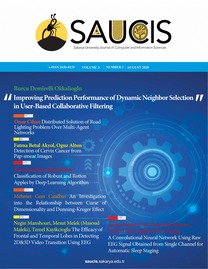Normal Cumulative Distribution Function and Dispersion Entropy Based EMG Classification
___
[1] J. J. A. Mendes Junior, M. L. B. Freitas, H. V. Siqueira, A. E. Lazzaretti, S. F. Pichorim, and S. L. Stevan, “Feature selection and dimensionality reduction: An extensive comparison in hand gesture classification by sEMG in eight channels armband approach,” Biomed. Signal Process. Control, vol. 59, 2020, doi: 10.1016/j.bspc.2020.101920.[2] Babita, P. Kumari, Y. Narayan, and L. Mathew, “Binary movement classification of sEMG signal using linear SVM and Wavelet Packet Transform,” 1st IEEE Int. Conf. Power Electron. Intell. Control Energy Syst. ICPEICES 2016, pp. 30–33, 2017, doi: 10.1109/ICPEICES.2016.7853640.
[3] C. Sravani, V. Bajaj, S. Taran, and A. Sengur, “Flexible Analytic Wavelet Transform Based Features for Physical Action Identification Using sEMG Signals,” IRBM, 2020, doi: 10.1016/j.irbm.2019.07.002.
[4] A. Arı, F. AYAZ, and D. HANBAY, “EMG Sinyallerinin Kısa Zamanlı Fourier Dönüşüm Özellikleri Kullanılarak Yapay Sinir Ağları ile Sınıflandırılması,” Fırat Üniversitesi Mühendislik Bilim. Derg., pp. 443–451, Sep. 2019, doi: 10.35234/fumbd.545161.
[5] C. Sapsanis, G. Georgoulas, A. Tzes, and D. Lymberopoulos, “Improving EMG based classification of basic hand movements using EMD,” Proc. Annu. Int. Conf. IEEE Eng. Med. Biol. Soc. EMBS, pp. 5754–5757, 2013, doi: 10.1109/EMBC.2013.6610858.
[6] J. Qi, G. Jiang, G. Li, Y. Sun, and B. Tao, “Intelligent Human-Computer Interaction Based on Surface EMG Gesture Recognition,” IEEE Access, vol. 7, pp. 61378–61387, 2019, doi: 10.1109/ACCESS.2019.2914728.
[7] N. A. Chaya, B. R. Bhavana, S. B. Anoogna, M. Hiranmai, and N. B. Krupa, “Real-Time Replication of Arm Movements Using Surface EMG Signals,” Procedia Comput. Sci., vol. 154, pp. 186–193, 2018, doi: 10.1016/j.procs.2019.06.028.
[8] A. Arı, B. Arı, and Ö. F. Alçin, “Elektromiyografi Sinyallerinin Permütasyon Entropi ve Bir Boyutlu Yerel İkili Özellikler Kullanılarak Sınıflandırılması,” J. Tepecik Educ. Res. Hosp., vol. 30, no. 1, pp. 46–49, 2020, [Online]. Available: https://www.journalagent.com/terh/pdfs/TERH_30_1_1_82.pdf.
[9] T. Tuncer, S. Dogan, and A. Subasi, “Surface EMG signal classification using ternary pattern and discrete wavelet transform based feature extraction for hand movement recognition,” Biomed. Signal Process. Control, vol. 58, p. 101872, 2020, doi: 10.1016/j.bspc.2020.101872.
[10] A. C. Turlapaty and B. Gokaraju, “Feature Analysis for Classification of Physical Actions Using Surface EMG Data,” IEEE Sens. J., vol. 19, no. 24, pp. 12196–12204, 2019, doi: 10.1109/JSEN.2019.2937979.
[11] Ö. F. Alçin, “Fraktal Eğimden Arındırılmış Dalgalılık Analizi ve Pencereli Kare Ortalamanın Karekökü Tabanlı EMG Sınıflandırma,” Fırat Üniversitesi Mühendislik Bilim. Derg., vol. 32, no. 2, pp. 359–368, 2020, doi: 10.35234/fumbd.771205.
[12] M. Rostaghi and H. Azami, “Dispersion Entropy: A Measure for Time-Series Analysis,” IEEE Signal Process. Lett., vol. 23, no. 5, pp. 610–614, 2016, doi: 10.1109/LSP.2016.2542881.
[13] H. Azami et al., “Multiscale fluctuation-based dispersion entropy and its applications to neurological diseases,” IEEE Access, vol. 7, pp. 68718–68733, 2019, doi: 10.1109/ACCESS.2019.2918560.
[14] M. Zanin, L. Zunino, O. A. Rosso, and D. Papo, “Permutation entropy and its main biomedical and econophysics applications: A review,” Entropy, vol. 14, no. 8, pp. 1553–1577, 2012, doi: 10.3390/e14081553.
[15] H. Azami, L. E. V. da Silva, A. C. M. Omoto, and A. Humeau-Heurtier, “Two-dimensional dispersion entropy: An information-theoretic method for irregularity analysis of images,” Signal Process. Image Commun., vol. 75, no. April, pp. 178–187, 2019, doi: 10.1016/j.image.2019.04.013.
[16] E. Kafantaris, I. Piper, T. Y. M. Lo, and J. Escudero, “Augmentation of dispersion entropy for handling missing and outlier samples in physiological signal monitoring,” Entropy, vol. 22, no. 3, 2020, doi: 10.3390/e22030319.
[17] M. Aslan, Y. Akbulut, A. Şengür, and M. C. Ince, “Skeleton based efficient fall detection,” J. Fac. Eng. Archit. Gazi Univ., 2017, doi: 10.17341/gazimmfd.369347.
[18] F. Demir, M. Turkoglu, M. Aslan, and A. Sengur, “A new pyramidal concatenated CNN approach for environmental sound classification,” Appl. Acoust., 2020, doi: 10.1016/j.apacoust.2020.107520.
[19] S. Yu, X. Li, X. Zhang, and H. Wang, “The OCS-SVM: An Objective-Cost-Sensitive SVM With Sample-Based Misclassification Cost Invariance,” IEEE Access, vol. 7, pp. 118931– 118942, 2019, doi: 10.1109/access.2019.2933437.
[20] X. Wu, W. Zuo, L. Lin, W. Jia, and D. Zhang, “F-SVM: Combination of Feature Transformation and SVM Learning via Convex Relaxation,” IEEE Trans. Neural Networks Learn. Syst., vol. 29, no. 11, pp. 5185–5199, 2018, doi: 10.1109/TNNLS.2018.2791507.
[21] O. F. Alcin, A. Sengur, J. Qian, and M. C. Ince, “OMP-ELM: Orthogonal matching pursuitbased extreme learning machine for regression,” J. Intell. Syst., 2015, doi: 10.1515/jisys-2014- 0095.
[22] G. Bin Huang, Q. Y. Zhu, and C. K. Siew, “Extreme learning machine: Theory and applications,” Neurocomputing, 2006, doi: 10.1016/j.neucom.2005.12.126.
- ISSN: 2636-8129
- Yayın Aralığı: Yılda 3 Sayı
- Başlangıç: 2018
Automatic Olive Peacock Spot Disease Recognition System Development by Using Single Shot Detector
A Comparison of the State-of-the-Art Deep Learning Platforms: An Experimental Study
Generative Networks and Royalty-Free Products
An Evaluation of VGG16 Binary Classifier Deep Neural Network for Noise and Blur Corrupted Images
Adding Virtual Objects to Realtime Face Images; A Case Study in Augmented Reality
Analysis of the Covid-19 Impact on Electricity Consumption and Production
Analysis of Different Types of Network Attacks on the GNS3 Platform
Energy Saving and Life Cycle Analysis of a Daylight-Linked Control System
Ceyda AKSOY TIRMIKÇI, Cenk YAVUZ
Sentiment Analysis for Software Engineering Domain in Turkish
Review on Bitcoin Price Prediction Using Machine Learning and Statistical Methods
